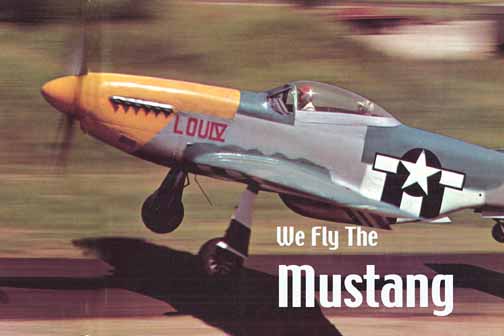

SCHOOL FOR WARBIRDS
PART FIVE - a month later
Here I am again at the Flying Tiger Air Museum in Paris, Texas, hiding in the back of a North American SNJ-5, for my second session of Junior Burchinal's how-to-be-a-fighter-pilot course.If things went according to schedule, I would get another couple of hops in the SNJ and then get ready to have a go at the P-51 Mustang. Just thinking about tangling with a 1,450hp, full-fledged fighter, after the trouble I'd had with a 600-hp trainer, made my knees turn to silly-putty. I've dreamed my entire life about flying a Mustang, and now that I was close, I wasn't sure whether it was a dream or a nightmare.
For some miraculous reason, all my troubles of a month ago disappeared, and the SNJ became just another airplane with a few oddball characteristics all its own. I even managed to make some decent three-points in a hard left crosswind. Junior decided to put me into the Mustang to taxi around some more and feel out its ground handling. I carefully (very carefully) added enough power to get it rolling and then found I couldn't pull back on the power hard enough to keep it from accelerating. Even at idle power that four-bladed prop out front wanted to drag me around at 50 mph, if I'd let it. It took little stabs of brake every so often to keep it from accelerating. The tailwheel lock is controlled by the stick. With the stick in any position except full forward, the tailwheel steers about six degrees either direction, plenty for taxiways and takeoffs and landings. Push the stick hard forward and you can feel it pull the locking pin out of the tailwheel mechanism allowing it to full swivel. With the stick back, the Mustang steers not unlike a Citabria with weak tail wheel/rudder springs. It's extremely easy to control and an absolute delight after dashing from rudder to rudder on the SNJ to keep from ending up in a ditch. The only trick is remembering to unlock the tailwheel while it's still rolling perfectly straight. If you are in even the slightest turn and try to unlock it, it won't go; the tailwheel will hop sideways, possibly damaging the tail post. The cockpit layout is not only well thought out, but is almost a duplicate of the SNJ. The left console under your arm has the flaps at the extreme rear. They're set in notches of about 10 degrees apiece up to 50 degrees. It takes a bit of twisting to get your arm back there, but there is no mistaking it for the gear handle. The top of the left console has the rudder and aileron trim knobs and the alternate air source levers. The handbook says to use 6 degrees right rudder trim for takeoff, which was an ominous warning if I ever saw one. The elevator trim is at the left edge of the seat and the gear handle is down by your left foot. You have to pull it in and then up, and there are no weight-actuated downlocks to prevent you from accidentally bringing the gear up on the ground, so you treat that handle with respect. The throttle is a Luger-like grip affair. Just inboard of the throttle is the prop pitch control and on the very back of the quadrant, moving up and down, is the mixture control. The handbook is full of detailed operating data and fills you with despair of ever figuring out all the systems, but once in the airplane, everything seems entirely normal and logical-except for the airspeed and manifold pressure gauges. The airspeed goes up to the astronomical number of 600 mph and the top of the green arc on the manifold pressure is 61 inches! My eyes could hardly focus on those numbers! GO TO PAGE SIX For lots more pilot reports like this one go to PILOT REPORTS. |